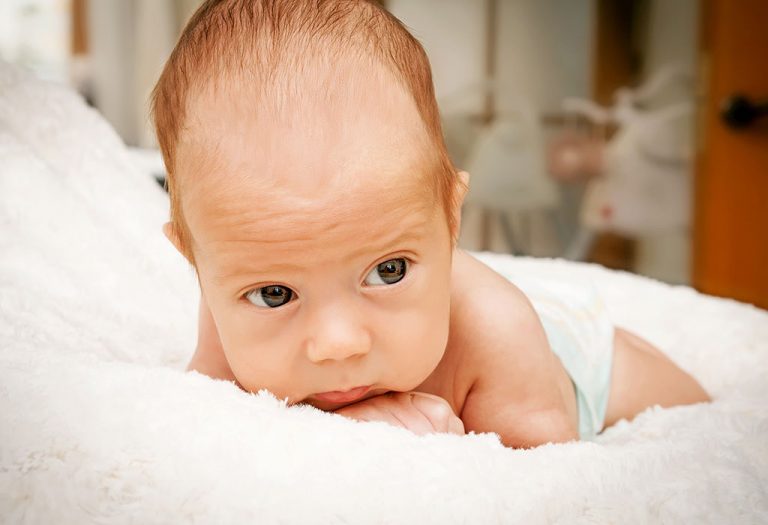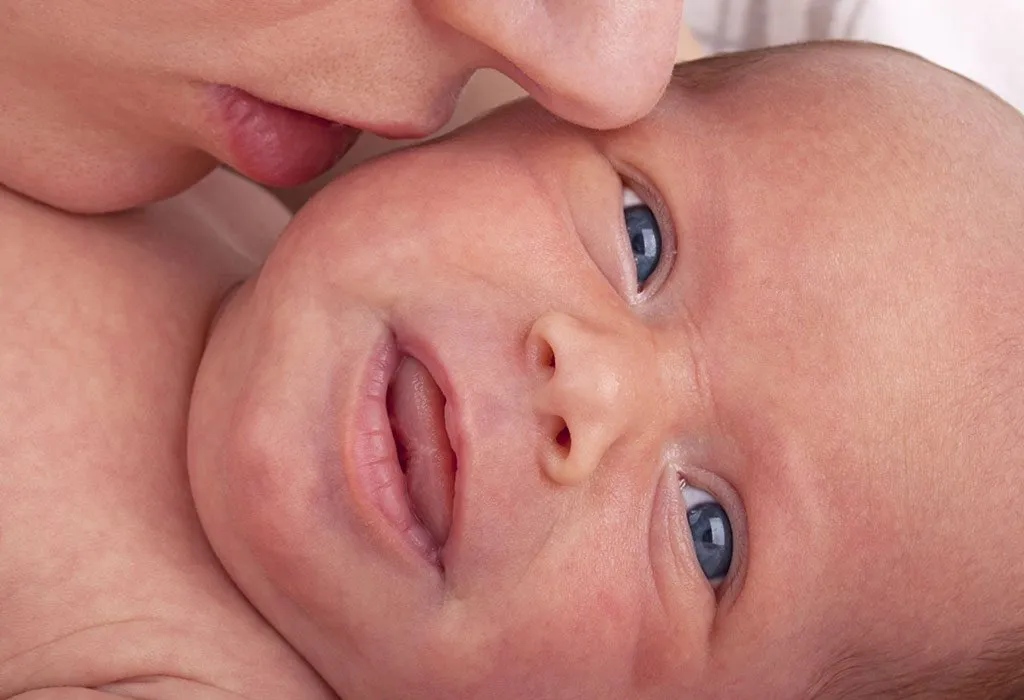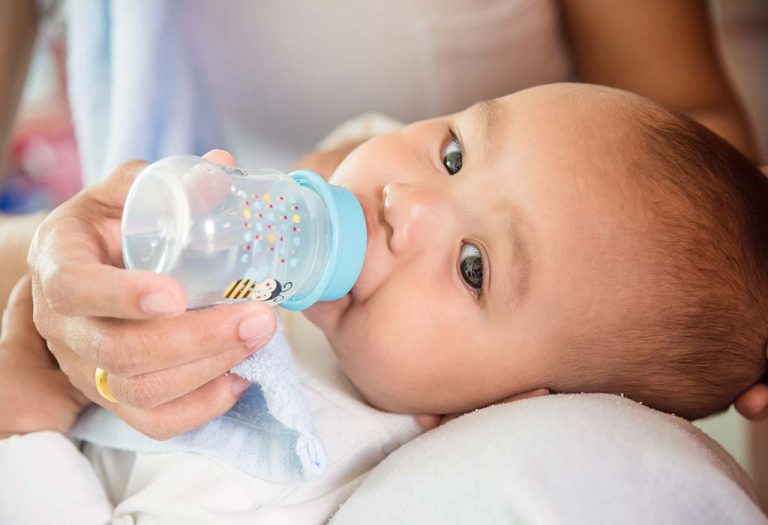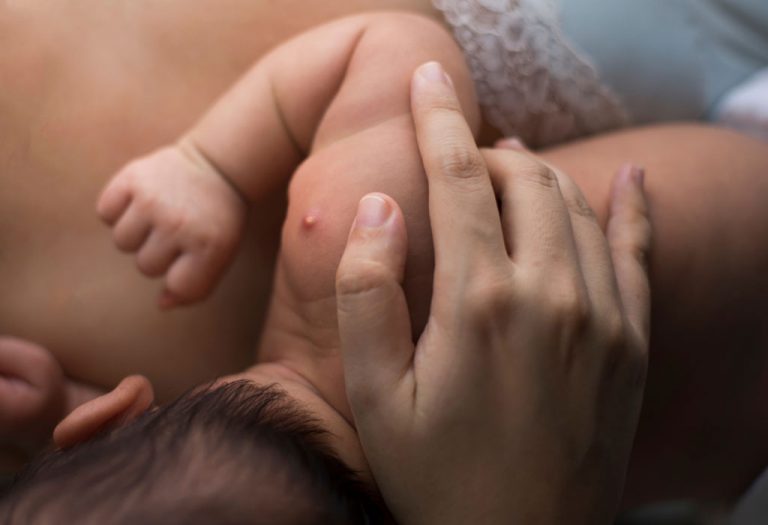Dark Circles Under Baby’s Eyes – Causes and Remedies

Your baby’s chubby cheeks, dimpled chin, curly hair, and sparkling wide eyes are irresistible, right? But, you may have noticed that as babies grow up, they develop dark circles or eye bags under their eyes. Dark circles aren’t as common in babies as they are in adults. If you find them, however, the cause most often is something that’s not of concern. They are usually caused by allergies and the baby’s lack of sleep or tiredness. Panicking if your baby has bags under the eyes won’t solve the problem. We recommend reading about the causes of dark circles under your baby’s eyes and remedies that can help you around them.
What are Dark Circles and How Do They Form?
Dark circles are blemishes around the baby’s eyes that are more prominent under the eyes. Several factors can cause dark circles by affecting the underlying anatomy of the region. The sensitive skin around the baby’s eyes is called periorbital skin, which is often thin and delicate. Underneath that skin are tiny blood vessels called infraorbital venous plexus, which connect with the nose. When this region is irritated, the blood vessels swell up and appear prominent as they come closer to the skin, which causes the entire area to appear dark circles. The periorbital skin is the area of skin that surrounds the eyelids. ‘Periorbital hyperpigmentation’ is used when dark circles are produced by higher than normal melanin production. Dark circles can appear when some babies have nasal congestion caused by allergens such as pollen. Sinusitis can also trigger dark circles when the sinus cavities, hollow areas around the nose become clogged and get infected by bacteria and other irritants. Even sleep deprivation can be a cause.
Is It Normal for Infants to Have Dark Circles Under Their Eyes?
Yes, it’s normal for babies to have dark circles around their eyes. The thin skin under their eye, richly supplied with tiny blood vessels, can sometimes pop up as dark circles. If there is a family history of sensitive under-eye skin and dark circles, the baby can be expected to have dark circles at some point.
What Do Dark Circles Under Infant’s Eyes Mean?
Most often, dark circles are not a cause for concern. They are caused by tiredness, allergies or could just be genetic. In extremely rare cases, however, dark circles can be caused by a tumour. A deficiency of vitamin K may also lead to dark circles. Talk to your doctor immediately if your baby has an unusually deep dark circle.
Causes of Dark Circles in Infants
Here are some common causes of dark circles in babies:
- The most common cause is the thin, delicate periorbital skin under the baby’s eyes which highlight the blood vessels, making them look darker. This is also called periorbital hyperpigmentation.
- Dark circles are also genetic and can be inherited. If family members have it, they shouldn’t be surprised if their babies have them too.
- Some babies have relatively thinner skin, making them look darker.
- Tired babies can also show dark circles. A long day in the sun or without much sleep can make their skin appear pale and the skin around the eyes darker.
- In rare cases, dark circles are caused by skin conditions related to bacterial infections, eczema, infection of the sinuses, respiratory infection, and dehydration could also cause dark or bluish circles under the baby’s eyes.
- Allergies are also known to cause dark circles, and those types are often called ‘allergic shiners’. Respiratory allergies and congestion of the nose can lead to a restriction of the blood flow in the veins under the eyes. This can appear prominent as a dark circle.
- Bulging eyes and black circles around the eyes may, in exceedingly rare circumstances, indicate a nerve tumour. The illness is known as neuroblastoma. Dark circles may be a sign that neuroblastoma has migrated to the area behind the eye – says a research conducted by UCSF Benioff Children’s Hospitals.
Remedies for A Baby’s Dark Circles
There are a few ways you can lessen your baby’s dark circles:
- Ensure they get enough rest at the proper times. Feed them healthy foods and keep them active to gain a healthy weight.
- If allergens cause their dark circles, keep them away from pollen, dust or animals. Clean under their eyes with a clean cloth soaked in warm water.
- Keep their hands clean and clip and file their nails to avoid unnecessary scratches on the face and eyes.
Can Dark Circles Under Eyes in Babies Be Prevented?
Dark circles cannot be prevented except for those caused by allergies and tiredness. Many mothers try homemade pastes such as ubtan to remove dark circles that are ineffective and can also be harmful.
Is There a Relation Between Dark Circles and Teething or Fever?
It is common for parents to associate fever and teething with dark circles, but there is no evidence from research that they are related.
Are Puffy Eyes Related to Dark Circles in Babies?
No, they are not related to dark circles. Puffy eyes can be caused by long spells of crying or sleeping in an awkward position.
Do Dark Circles Indicate Poor Health or Improper Sleep?
Contrary to the popular opinion among parents, dark circles in babies are rarely an indicator of poor health or sleep routines.
Are Dark Circles Associated with Under-eye Bags?
Under-eye bags could be fat under the skin under your baby’s eyes and have nothing to do with dark circles.
When to Consult a Doctor?
Here are some situations when you should consult a doctor when the baby has dark circles under the eyes. However, these guidelines are general, and each baby is unique. You must tell your doctor about your specific situation to get the best advice:
1. Persistent or Severe Dark Circles: If you notice persistent or severe dark circles under your baby’s eyes that do not seem to improve with time, it is advisable to consult a doctor. Dark circles can sometimes indicate an underlying health issue, such as allergies, anaemia, or dehydration. Facial structure and vitamin K insufficiency might also contribute to dark circles under the eyes.
2. Accompanied by Other Symptoms: If your baby’s dark circles are accompanied by other concerning symptoms such as excessive fatigue, poor appetite, weight loss, irritability, or unusual skin changes could indicate an underlying medical condition such as liver disease that requires attention. A doctor can evaluate the symptoms comprehensively to determine the cause and provide appropriate treatment.
3. Unexplained or Sudden Onset: Sudden or unexplained physical appearance changes can sometimes indicate an underlying health problem.
4. Parental Concern: As a parent, it is essential to trust your instincts. If you are genuinely concerned about your baby’s dark circles or feel something is amiss, it is always better to seek medical advice. Even if the cause of the dark circles is relatively benign, a doctor can provide reassurance and address any parental concerns, ensuring the well-being of both the baby and the parents.
FAQ
1. Why Do Sometimes I Observe Redness Under My Baby’s Eyes?
These are general reasons for redness under a baby’s eyes:
1. Allergies: Redness under your baby’s eyes may be due to allergies, such as pollen or pet dander. Consult a doctor if redness persists or is accompanied by other allergy symptoms.
2. Eye Strain or Fatigue: Excessive screen time or intense activities can lead to redness under your baby’s eyes. Encourage breaks and appropriate lighting. Seek medical advice if redness persists or is accompanied by concerning symptoms.
3. Conjunctivitis: “Pink eye” can cause redness, itching, and discharge. Consult a healthcare professional for diagnosis and treatment.
4. Environmental Factors: Dry air, irritants, or weather changes can contribute to redness. Maintain proper humidity, avoid irritants, and use recommended eye drops. Consult a doctor if the redness continues.
In almost all cases, dark circles are not of concern and will resolve on their own when the underlying trigger subsides.
References/Resources:
1. Sarkar. R, Ranjan. R, Garg. S, et al.; Periorbital Hyperpigmentation: A Comprehensive Review; PubMed Central; https://www.ncbi.nlm.nih.gov/pmc/articles/PMC4756872/; January 2016
2. WHAT ARE THOSE DARK CIRCLES UNDER MY CHILD’S EYES?; healthcare utah; https://healthcare.utah.edu/the-scope/kids-zone/all/2021/02/what-are-those-dark-circles-under-my-childs-eyes; February 2021
3. Gendler. EC; Treatment of Periorbital Hyperpigmentation; Oxford Academic; https://academic.oup.com/asj/article/25/6/618/188803; November 2005
4. Neuroblastoma; UCSF; https://www.ucsfbenioffchildrens.org/conditions/neuroblastoma
5. Pediatric Neuroblastoma; Childhrennational; https://childrensnational.org/visit/conditions-and-treatments/cancer/neuroblastoma
6. Cirrhosis of the Liver; Cleveland Clinic; https://my.clevelandclinic.org/health/diseases/15572-cirrhosis-of-the-liver
7. Additional Clinical Features; Rady Children Hospital; https://www.rchsd.org/programs-services/dermatology/eczema-and-inflammatory-skin-disease-center/clinical-features/additional-clinical-features/
Also Read:
Eye Problems in Newborn
Reasons of Eye Discharge in Babies
Symptoms of Eye Infections in Babies
Was This Article Helpful?
Parenting is a huge responsibility, for you as a caregiver, but also for us as a parenting content platform. We understand that and take our responsibility of creating credible content seriously. FirstCry Parenting articles are written and published only after extensive research using factually sound references to deliver quality content that is accurate, validated by experts, and completely reliable. To understand how we go about creating content that is credible, read our editorial policy here.

























